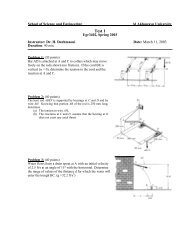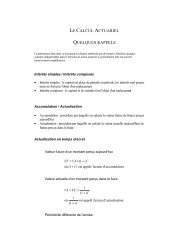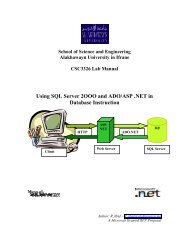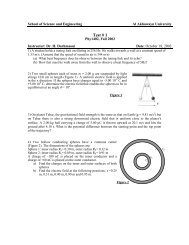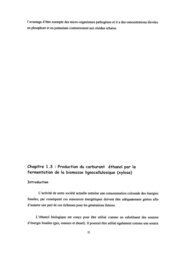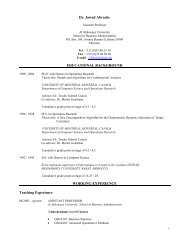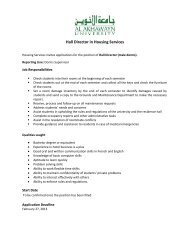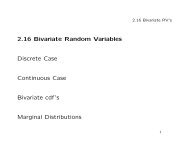Leadership and Values in Language Education - Al Akhawayn ...
Leadership and Values in Language Education - Al Akhawayn ...
Leadership and Values in Language Education - Al Akhawayn ...
- No tags were found...
Create successful ePaper yourself
Turn your PDF publications into a flip-book with our unique Google optimized e-Paper software.
116Proceed<strong>in</strong>gs of the 27 th MATE Annual Conference<strong>in</strong> turn, help them develop a variety of organizational <strong>and</strong> <strong>in</strong>teractional skills, aswell as the personality traits associated with them, such as tolerance, mutualleadership <strong>and</strong> appreciation of diversity. The practice of shared leadership on thepart of students requires them to assume an active, participatory, creative, <strong>and</strong>productive role <strong>in</strong> classroom communication <strong>and</strong> organization. This successfulengagement <strong>in</strong> shared leadership practice would certa<strong>in</strong>ly contribute to teachers’professional development <strong>and</strong> would help students to develop life long learn<strong>in</strong>gabilities, that is, “the ability to cont<strong>in</strong>ue learn<strong>in</strong>g after the end of their formaleducation” (Littlewood,1999: 71). It would also help them to grow as “authenticpersons [who] know what they are do<strong>in</strong>g, <strong>and</strong> attend <strong>in</strong> relaxed or focused ways,<strong>in</strong> accordance with the dem<strong>and</strong>s of the situation, [who] are also autonomous, <strong>in</strong>the sense of feel<strong>in</strong>g responsible for their own actions, <strong>and</strong> able to deal withchoices” (Vanlier, 1996: 144).2. 2. Two-way communicationIn the literature on classroom communication (e.g. Johnson, 1995 <strong>and</strong> Lynch,1996, etc.), two types of communication have been dist<strong>in</strong>guished. The first type isone-way communication where the <strong>in</strong>itiative-response-evaluation/feedback<strong>in</strong>teractional sequence is the dom<strong>in</strong>ant structure of communication. This structureallows the teacher to control the structure <strong>and</strong> content of communication whichbecomes a process of top-down <strong>in</strong>fluence <strong>and</strong> allows leadership to be centralized<strong>in</strong> the h<strong>and</strong>s of a s<strong>in</strong>gle participant, the teacher, the formally appo<strong>in</strong>ted leader,who leaves little space for other participants/students to practice the <strong>in</strong>teractionalcompetencies recommended by advocates of shared leadership. This pattern ofparticipation reflects the traditional vertical approaches to leadership which isclosely related to teacher-centred approaches to second <strong>and</strong> foreign languageteach<strong>in</strong>g <strong>and</strong> learn<strong>in</strong>g.Shared leadership education suggests a view of communication as an <strong>in</strong>tegrated<strong>and</strong> complex process which is achieved through <strong>in</strong>teractive language use,collaborative <strong>and</strong> cooperative negotiation of mean<strong>in</strong>g, <strong>and</strong> shared underst<strong>and</strong><strong>in</strong>gbetween participants <strong>in</strong> communication <strong>in</strong> general <strong>and</strong> classroom communication<strong>in</strong> particular <strong>in</strong> order to sort out misunderst<strong>and</strong><strong>in</strong>g <strong>and</strong> communication problems<strong>and</strong> breakdowns. It is a two-way communication which stresses the centrality of<strong>in</strong>teractive communication or “the <strong>in</strong>teractional nature of dialogue, one of thecoord<strong>in</strong>at<strong>in</strong>g practices of shared leadership” (Yukle, 1998). With<strong>in</strong> theperspective of this type of communication, the emphasis is placed on students’active <strong>and</strong> motivated participation <strong>in</strong> open <strong>and</strong> free communication whereby theycould exchange op<strong>in</strong>ions, share ideas, chair discussions, <strong>and</strong> practice different<strong>in</strong>teractional skills <strong>and</strong> various speech acts <strong>and</strong> exercise a great deal of control





